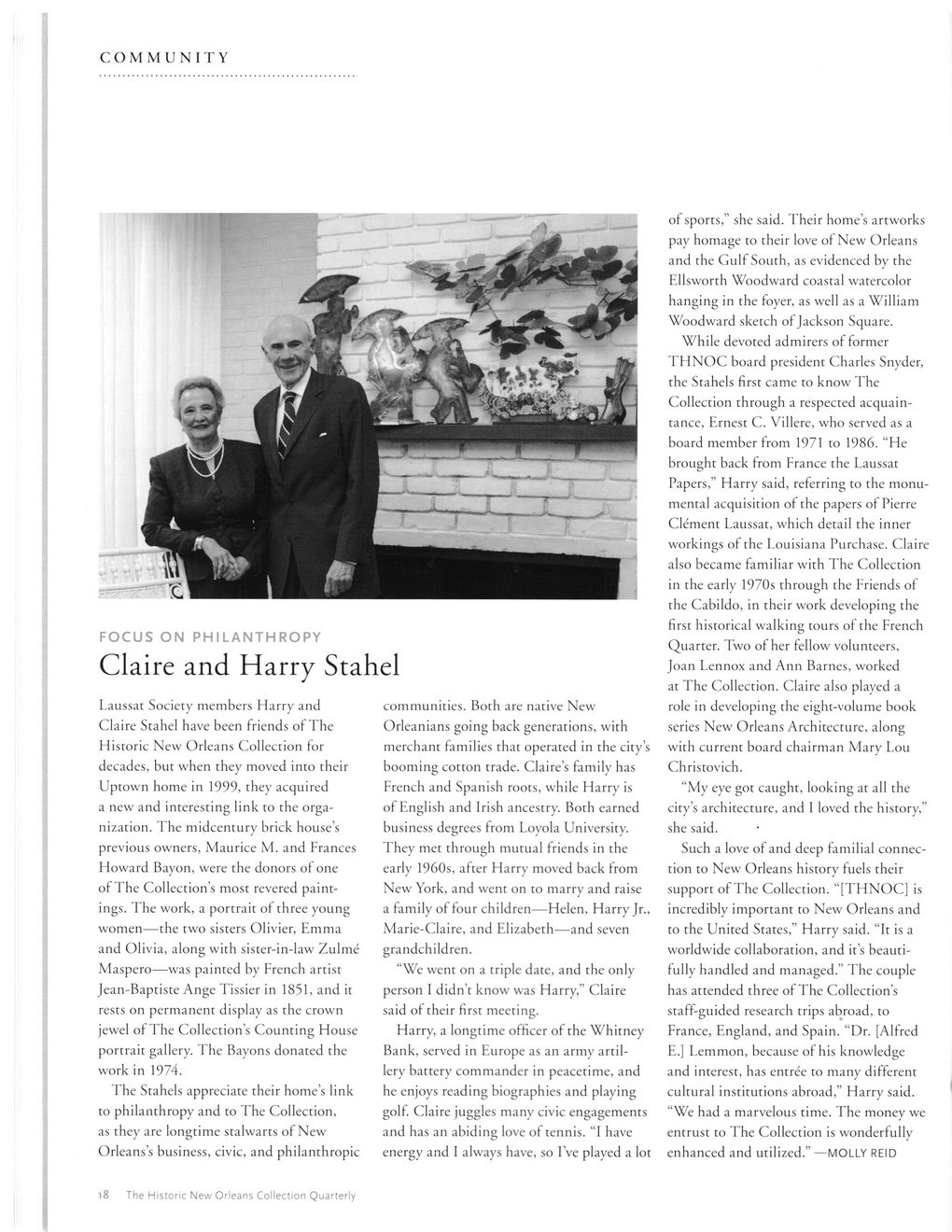This text was obtained via automated optical character recognition.
It has not been edited and may therefore contain several errors.
COMMUNITY FOCUS ON PHILANTHROPY Claire and Harry Stahel Laussat Society members Harry and Claire Stahel have been friends ofThe Historic New Orleans Collection for decades, but when they moved into their Uptown home in 1999, they acquired a new and interesting link to the organization. The midcentury brick house’s previous owners, Maurice M. and Frances Howard Bayon, were the donors of one ofThe Collection’s most revered paintings. The work, a portrait of three young women—the two sisters Olivier, Emma and Olivia, along with sister-in-law Zulme Maspero—was painted by French artist Jean-Baptiste Ange Tissier in 1851, and it rests on permanent display as the crown jewel ofThe Collection’s Counting House portrait gallery. The Bayons donated the work in 1974. The Stahels appreciate their home’s link to philanthropy and to The Collection, as they are longtime stalwarts of New Orleans’s business, civic, and philanthropic communities. Both are native New Orleanians going back generations, with merchant families that operated in the city’s booming cotton trade. Claire’s family has French and Spanish roots, while Harry is of English and Irish ancestry. Both earned business degrees from Loyola University. They met through mutual friends in the early 1960s, after Harry moved back from New York, and went on to marry and raise a family of four children—Helen, Harry Jr., Marie-Claire, and Elizabeth—and seven grandchildren. “We went on a triple date, and the only person I didn’t know was Harry,” Claire said of their first meeting. Harry, a longtime officer of the Whitney Bank, served in Europe as an army artillery battery commander in peacetime, and he enjoys reading biographies and playing golf. Claire juggles many civic engagements and has an abiding love of tennis. “I have energy and I always have, so I’ve played a lot of sports,” she said. Their home’s artworks pay homage to their love of New Orleans and the Gulf South, as evidenced by the Ellsworth Woodward coastal watercolor hanging in the foyer, as well as a William Woodward sketch of Jackson Square. While devoted admirers of former THNOC board president Charles Snyder, the Stahels first came to know The Collection through a respected acquaintance, Ernest C. Villere, who served as a board member from 1971 to 1986. “He brought back from France the Laussat Papers,” Harry said, referring to the monumental acquisition of the papers of Pierre Clement Laussat, which detail the inner workings of the Louisiana Purchase. Claire also became familiar with The Collection in the early 1970s through the Friends of the Cabildo, in their work developing the first historical walking tours of the French Quarter. Two of her fellow volunteers, Joan Lennox and Ann Barnes, worked at The Collection. Claire also played a role in developing the eight-volume book series New Orleans Architecture, along with current board chairman Mary Lou Christovich. “My eye got caught, looking at all the city’s architecture, and I loved the history,” she said. Such a love of and deep familial connection to New Orleans history fuels their support ofThe Collection. “[THNOC] is incredibly important to New Orleans and to the United States,” Harry said. “It is a worldwide collaboration, and it’s beautifully handled and managed.” The couple has attended three ofThe Collection’s staff-guided research trips abroad, to France, England, and Spain. “Dr. [Alfred E.] Lemmon, because of his knowledge and interest, has entree to many different cultural institutions abroad,” Harry said. “We had a marvelous time. The money we entrust to The Collection is wonderfully enhanced and utilized.”—MOLLY REID 18 The Historic New Orleans Collection Quarterly

New Orleans Quarterly 2015 Spring (21)